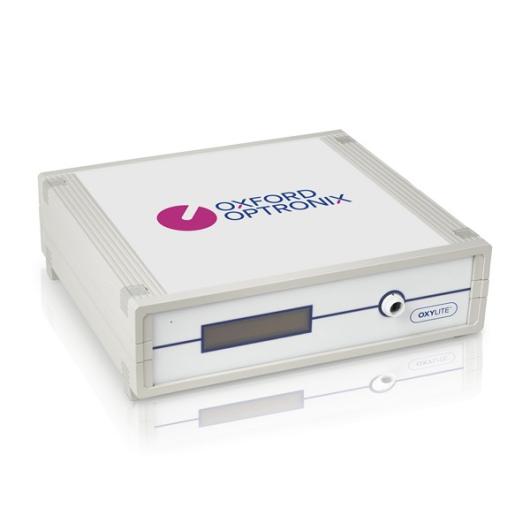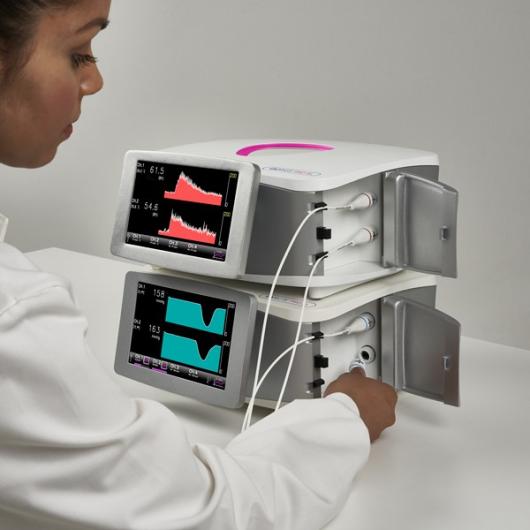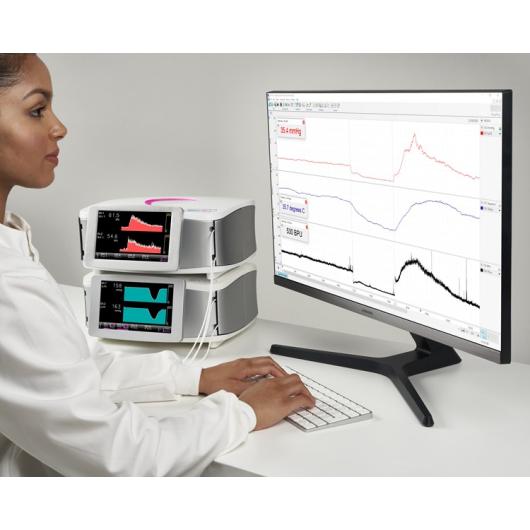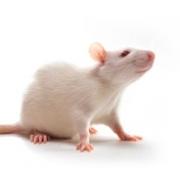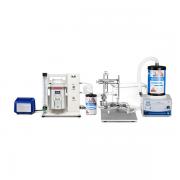





OxyLite
Dissolved oxygen (pO2) and temperature monitors in 3 versions: single-channel, two- and four-channel. Ask us for rent to your laboratory.
Instrument rental conditions are as such:
- Minimum term – 2 months
- Extendable in 1 or 2 month increments at above pcm price
- Oxygen sensors are purchase-only (per list price)
- Laser Doppler probes only can be rented, subject to availability
- Subject to monitor availability
- Delivery and Return carriage and insurance costs to be borne by the customer or distributor
- All damage, other than fair wear and tear will be chargeable
A szövetek és szervek túlélése az oxigén megfelelő ellátottságán múlik. A szöveti oxigénnyomás (ptiO2) mérése közvetlenül mutatja az oxigénellátás (vér által) és az oxigénfogyasztás (szövet által) egyensúlyát, vagyis az oxigén elérhetőségét sejtszinten. Ez ellentétben áll a spektroszkópiai (NIRS) technikákkal, amelyek csak a hemoglobin oxigénellátottsági állapotát mutatják.
Az OxyLite™ oxigénmonitorok különösen érdekesek lehetnek azoknak az élettudományi kutatóknak, akik közvetlenül és folyamatosan szeretnék mérni az oldott oxigént a normál fiziológiás és hipoxiás tartományokban, akár kísérleti in vivo modellekben, akár különféle in vitro alkalmazásokban.
1998-ban, amikor az Oxford Optronix úttörőként vezette be a száloptikás oxigénmikroszenzor technológiát a piacon, az OxyLite™ márka nemzetközileg elismertté vált az orvosi és élettudományi kutatásokban, több mint 500 szakmailag lektorált cikkben hivatkozva, valamint világszerte több száz eladott egységgel.
2013-ban több mint másfél évtizedes folyamatos K+F eredményeként bemutattuk harmadik generációs szöveti oxigénmonitorjainkat. A modern dizájn, a valódi „plug and play” kényelme és a legújabb optoelektronikai technológia ötvözésével az OxyLite™ Pro rendszereink a piacon elérhető legfejlettebb, legpontosabb és legmegbízhatóbb szöveti oxigénmonitorozási platformot kínálják.
Oxigénszenzoraink a legmodernebb optikai fluoreszcencia technológiát alkalmazzák, amely az oxigén parciális nyomásának (pO2) és a hőmérséklet mennyiségi mérésére szolgál szövetekben, fiziológiás folyadékokban, sejtkultúrákban és egyéb in vitro alkalmazásokban. Ez a technológia számos előnyt kínál a polarográfiás technológián alapuló eszközökkel szemben, így oxigénmonitorjaink sokkal könnyebben használhatók, és ideálisan alkalmasak az oxigénmérésekre a tipikus fiziológiás tartományban, valamint rendkívüli érzékenységet biztosítanak hipoxiás körülmények között.
OxyLite és OxyLite Pro alkalmazások
- Tumor angiogenezis és oxigénellátottság
- Létfontosságú szervek oxigénellátottsága transzplantáció során és sokk monitorozása
- Agyi oxigénellátottság sztrók alatt
- Agy- és gerincvelő-sérülés
- Szöveti lebeny és seb oxigénellátottság
- pO2 monitorozás a szemben
- Oldott oxigén mérés hipoxiás sejtkultúrákban, bioreaktorokban stb.
Az OxyLite fő előnyei
A világ legkönnyebben használható oldott oxigén monitorai!
Nincs szükség kalibrációra, nincs szenzor elmozdulás, nincs kötelező PC/szoftver interfész, integrált hőmérséklet-kompenzáció, az oxigén parciális nyomása abszolút mmHg egységekben jelenik meg: az OxyLite™ oxigénmonitorok a jelenleg elérhető legfelhasználóbarátabb oxigénmonitorok!
Oldott oxigén abszolút egységekben
A fluoreszcencia-alapú technológia abszolút mérési eredményt ad az oldott oxigén mennyiségéről mmHg vagy kPa egységekben. In vivo ez közvetlen leolvasást ad az oxigén elérhetőségéről a sejtekhez és szövetekhez, szemben a vér oxigéntelítettségének értékelésével (pulzoximéter), amely csak a vér hemoglobin oxigénellátottságát mutatja.
Érzékenység és pontosság
Harmadik generációs optoelektronikai technológia páratlan érzékenységet, stabilitást és pontosságot biztosít a fiziológiásan releváns pO2 tartományban (0–200 mmHg), valamint hipoxiás körülmények között (0–15 mmHg).
Oxigénfogyasztás nélkül
Zéró oxigénfogyasztás a mérési ponton, így folyamatos és abszolút oxigénérzékelésre alkalmas, még extrém hipoxiás körülmények között is.
Mikrochip szenzorok
Az „EEPROM” technológia a csatlakozókba van beépítve, ami kivételesen könnyű használatot biztosít, teljesen kiküszöbölve a kalibrálási eljárásokat. Egyszerűen „csatlakoztassa és használja”!
Érintőképernyős kijelző és interfész
Az OxyLite™ Pro modellek érintésérzékeny, nagy kontrasztú, 140 fokos betekintési szögű képernyővel rendelkeznek, amely valós idejű adatokat jelenít meg digitális és grafikus formátumban, valamint hozzáférést biztosít az eszköz- és felhasználói beállításokhoz.
Beépített hőmérséklet-kompenzáció
Az opcionális, integrált hőmérséklet-szenzorok révén a pO2 mérés automatikusan hőmérséklet-kompenzált.
Sokoldalúság
Teljes támogatás mind in vivo (szöveti) pO2 alkalmazásokhoz, mind oldott oxigén méréshez in vitro környezetben (pl. hipoxiás sejttenyészetek, szöveti konstrukciók, bioreaktorok és mások).
Minimálisan invazív in vivo alkalmazásokhoz
Az oxigénszenzor átmérője 230 µm és 750 µm között mozog, így sokféle szöveti monitorozási alkalmazáshoz használható, és minimalizálja a szövetkárosodást.
MRI kompatibilitás
Speciális szenzortípusok biztosítanak támogatást és kompatibilitást mágneses rezonanciás képalkotással (csak bizonyos szenzortípusok).
Többcsatornás termelékenység
Az OxyLite™ Pro elérhető kétcsatornás modellként, vagy egyedi módon négycsatornás eszközként (OxyLite™ Pro XL), amely akár négy szenzort is képes egyszerre működtetni. Ez rugalmasságot biztosít több szöveti hely oxigénszintjének egyidejű monitorozására (pl. patológiás és kontrollszövetek összehasonlítása), vagy több in vitro minta egyidejű mérésére.
Frissíthető
Az OxyLite™ Pro kétcsatornás modell gyárilag frissíthető négycsatornás modellre (OxyLite™ Pro XL).
Egyszenzoros többparaméteres monitorozás
Az OxyLite™ oxigénmonitorokat speciálisan az OxyFlo™ véráramlás monitorokkal való használatra fejlesztették ki. E két száloptikás mérőrendszer kombinációja lehetővé teszi a szöveti véráramlás és oxigénellátottság egyidejű mérését.
USB digitális kimenet
Az összes szöveti monitorozó eszközünk mostantól USB kimenettel rendelkezik, amely támogatja a valós idejű felvételek közvetlen továbbítását egy PC-re, amely az ADInstruments népszerű LabChart® Pro* charting szoftverét futtatja. A díjmentesen letölthető kiegészítő telepítését követően a LabChart automatikusan felismeri az Oxford Optronix monitor típusát és modelljét, valamint előre betölti az összes szükséges konfigurációs és csatornabeállítást, biztosítva a végső „plug and play” kényelmet. Azoknak a kutatóknak, akik többparaméteres méréseket kívánnak végezni, a kiegészítő támogatja több Oxford Optronix eszköz egyidejű használatát. Az adatgyűjtés és rögzítés mostantól sokkal könnyebbé vált!
Analóg kimenetek
A folyamatos adatfelvétel PC-re vagy Mac-re szabványos analóg adatkimeneteken keresztül is támogatott, kompatibilitást biztosítva harmadik fél adatfelvételi megoldásaival.
Felhasználási nyilatkozat:
Az OxyLite™ és OxyLite™ Pro kizárólag laboratóriumi, ipari és kutatási célokra készült.
Az OxyLite™ és OxyLite™ Pro nem alkalmazható embereken vagy betegeken.
- Méretek
OxyLite: 95 mm (H) x 290 mm (Sz) x 260 mm (M)
OxyLite Pro: 150 mm (H) x 310 mm (Sz) x 280 mm (M) - Súly
OxyLite: 2 kg / 4,5 lbs
OxyLite Pro: 4 kg / 9 lbs - Működési hőmérséklet
10 – 30°C - Működési páratartalom
0 – 70% (nem kondenzáló) - Tápegység követelmények
OxyLite: VAC 100-240V, 50-60Hz, 30W max
OxyLite Pro: Külső PSU (100-240V/50-60Hz), 40W max - Biztosíték értékelés
OxyLite: 2 x T1.6A
OxyLite Pro: Nem alkalmazható - Támogatott érzékelők száma / Csatornák száma
OxyLite: 1
OxyLite Pro: 2
OxyLite Pro XL: 4 - Kijelző
OxyLite: 40 karakteres alfanumerikus OLED
OxyLite Pro: Magas kontrasztú 800 x 480 LCD érintőképernyő - Eszköz konfigurálása
OxyLite: A hátsó funkciógombbal
OxyLite Pro: Érintőképernyős kijelzőn keresztül - Analóg feszültség kimenetek
OxyLite: 2 x jobb oldali BNC csatlakozó (2 kimenet)
OxyLite Pro: 1 x 15 tűs D-típusú (4 kimenet)
OxyLite Pro XL: 2 x 15 tűs D-típusú (8 kimenet) - LED gerjesztési hullámhossz
525 nm - Lumineszcencia hullámhossz
650 nm - TELJESÍTMÉNY
- Működési mód
Lumineszcencia elhalványulás élettartama (pO2) / T-típusú termosztát vagy manuális felhasználói bemenet (hőmérséklet) - Mértékegységek (megjelenítve)
mmHg vagy kPa / °C - Mérési tartomány
0 – 200 mmHg; 0 – 26,6 kPa / 0 – 50°C - Mérési felbontás
0,1 mmHg / 0,1 °C - Mérési pontosság
Oxigén:
±0,7 mmHg (0 – 7 mmHg)
±10% az olvasott értékből (7 – 150 mmHg)
±15% az olvasott értékből (150 – 200 mmHg)
Hőmérséklet: ±0,2 °C - Mérési válaszidő
< 20 s (standard oxigén érzékelő) / < 2 s (hőmérséklet) - Mérési mintavételi sebesség
1 Hz (felhasználó által meghatározható az OxyLite Pro modelleken - Mérési adatgyűjtési idő
1s - Mérési átlagolás
5 s, gördülő - Kijelző frissítési intervallum (numerikus)
2 s (5 s gördülő átlagolt) - Validált hőmérséklet kompenzálási tartomány
10°C – 45°C - Érzékelő azonosítás
Automatikus; integrált csatlakozó EEPROM - Érzékelő kalibrálás
Gyári elő-kalibrálás (érzékelőnként egyedi); érvényes 6 hónapig - Érzékelő tárolási ideje
2 év a gyári kalibrálás után (használt vagy nem használt) - Érzékelő élettartama
48 órányi összesített használat alapértelmezett mintavételi sebességnél - Analóg adat kimeneti tartomány
0 – 5 V (0 – 200 mmHg / 0 – 50 °C) (alapértelmezett) - Analóg adat kimeneti sebesség
1 Hz
- OxyLite rendszerhez való érzékelők
- LabChart® Pro
- PowerLab®
- Value ADC 12-bemenetes analóg adatgyűjtő modul
- NX-CI ADAPTER beültethető ('CI' típusú) oxigén érzékelők számára
- BNC adatkábelek
- BNC adapter kábel OxyLite Pro és OxyFlo Pro modellekhez
Download full publication list.
In vivo tissue oxygenation: How do I know which method is best for my research?
by Sarah McFarlane, 18 October 2019
Understanding oxygen sensing in cells: A video lecture by Dr. Peter Ratcliffe.
by Justin Croft, 27 August 2019
Investigating mechanisms driving acute kidney injury arising from heart surgery and sepsis.
by Sarah McFarlane, 12 July 2019
Marina N et al. (2020). Astrocytes monitor cerebral perfusion and control systemic circulation to maintain brain blood flow. Nat Commun 11(1), 131
Sheng T, Ong YH, Guo W and Zhu T (2020). Reactive oxygen species explicit dosimetry to predict tumor growth for benzoporphyrin derivative-mediated vascular photodynamic therapy. J Biomed Opt. 25(6), 1-13
Gehrung M, Bohndiek SE and Brunker J (2019). Development of a blood oxygenation phantom for photoacoustic tomography combined with online pO2 detection and flow spectrometry. J Biomed Opt. 24(12), 1-11
Tran CHT, George AG, Teskey GC and Gordon GR (2019). Seizures cause sustained microvascular constriction associated with astrocytic and vascular smooth muscle Ca2+ recruitment. bioRxiv http://dx.doi.org/10.1101/644039
Baark F, Shaughnessy F, Pell VR, Clark JE, Eykyn TR, Blower P and Southworth R (2019). Tissue acidosis does not mediate the hypoxia selectivity of [64Cu][Cu(ATSM)] in the isolated perfused rat heart. Sci Rep 9(1), 499
Bodo S, et al. (2019). Single-dose radiotherapy disables tumor cell homologous recombination via ischemia/reperfusion injury. J Clin Invest. 129(2), 786-801
Dr Elizabeth Morgan, National Oceanography Centre, University of Southampton, UK
“I use the BF/OT/E PO2 E-series sensor to measure PaO2 in vivo in invertebrates during external environmental fluctuations in PO2. Due to the accuracy and reliability of the PO2 probes we can design experiments that provide real time measurements of PO2 during changes in environmental variables and more accurately link this to behavioural responses. During the experimental set up the staff at Oxford Optronix were always on hand to help out with any technical queries and even visited the laboratory to check out the experimental set up and ensure the probes were working. I would recommend Oxford Optronix to anyone with an interest in measuring PO2 and temperature in marine science.”
Dr Catherine Hoare, Hope Hospital, Manchester, UK
“One particularly useful ability of the OxyLite [is the ability] to observe the oxygen measurements alongside absorbance readings, plotting both the oxygen and enzyme kinetics. This would never have been possible with a standard Clarke Electrode. I am genuinely impressed with the OxyLite, its range of applications and its ease of use. I would be more than happy to recommend it to the scientific community.”
Dr Thies Schroeder, Duke University Medical Center, Department of Radiation Oncology, Durham NC, United States
“Our group has successfully applied OxyLite needle probes to measure changes in tissue oxygenation in response to drug treatment. OxyLite has allowed us to collect important mechanistic data to identify the mechanism of these drug treatments in laboratory animals. We greatly appreciate having a calibrated method like the OxyLite probe technology available that allows the collection of accurate, real-time physiological data from live animals.”
Dr. Roger Evans, Monash University, Department of Physiology, Melbourne, Australia
“Your equipment has taken me to some weird and wonderful places and contributed to about a dozen original articles over the last decade.”
| Termék neve | |
|---|---|
| OxyLite Single-channel dissolved oxygen (pO2) and temperature monitor | |
| OxyLite Pro Two-channel dissolved oxygen (pO2) and temperature monitors with touch-screen | |
| OxyLite Pro XL Four-channel dissolved oxygen (pO2) and temperature monitors with touch-screen |

